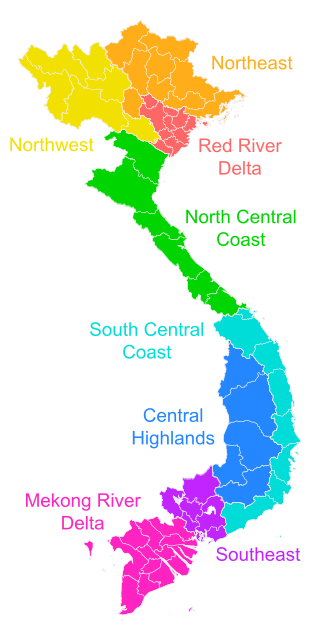Subdivisions of Vietnam
From Wikipedia, the free encyclopedia
Vietnam is divided into 57 provinces and 6 municipalities. It is a unitary state.
Administrative units
Summarize
Perspective
Pursuant to the constitution, there are three levels of administrative divisions in Vietnam: provinces, districts, and communes. Depending on the level of urbanisation, each level of administrative division comprises multiple types of administrative units:
- Provincial level: autonomous municipality (thành phố trực thuộc trung ương, literally city subordinate to central authority) and province (tỉnh)
- District level: municipal city (thành phố thuộc thành phố trực thuộc trung ương, literally city in a city subordinate to central authority),[1] urban district (quận), provincial city (thành phố thuộc tỉnh, literally city in a province), town (thị xã) and rural district (huyện)
- Commune level: ward (phường) in major urban areas (under urban districts, cities or towns), township (thị trấn) for stand-alone townlets and commune (xã) for rural areas

A fourth, unofficial tier also exists, including hamlets (xóm, ấp), villages (làng, thôn, bản) and neighbourhoods (tổ dân phố, khu phố).
| Level | Provincial level | District level | Commune level |
|---|---|---|---|
| Type | Municipality (Thành phố trực thuộc trung ương) | Municipal city (Thành phố thuộc thành phố trực thuộc trung ương) | Ward (Phường) |
| Commune (Xã) | |||
| Urban district/borough (Quận) |
Ward (Phường) | ||
| Town (Thị xã) |
Ward (Phường) | ||
| Commune (Xã) | |||
| Rural district (Huyện) |
Township (Thị trấn) | ||
| Commune (Xã) | |||
| Province (Tỉnh) |
Provincial city (Thành phố thuộc tỉnh) | Ward (Phường) | |
| Commune (Xã) | |||
| Town (Thị xã) | Ward (Phường) | ||
| Commune (Xã) | |||
| Rural district (Huyện) | Township (Thị trấn) | ||
| Commune (Xã) |
First level
On the first level, there are 6 municipalities and 57 provinces.
Second level
Municipalities are subdivided into district-level cities (municipal cities), urban districts, towns, and rural districts. There is no official capital or seat of the municipality but local authority headquarters are usually located in one or more central urban districts.
Provinces are subdivided into district-level cities (provincial cities), towns, and rural districts. Currently, all provinces have their capitals in a district-level city, although some were previously towns.
As of 1 September 2024, there are 704 second-tier units.[2]
As urbanisation progresses, rural districts may be reclassified as towns, then to provincial cities (or towns and municipal cities in municipalities, and eventually to urban districts if they merge into the central urban area of a municipality). Note that the term
Third level
Urban districts are subdivided into wards, while cities and towns are subdivided into (urban) wards and (rural) communes. Rural districts are subdivided into (urban) townships (or townlets) and (rural) communes. Only rural districts have designated capitals, usually in a township.
As of 1 September 2024, there are 10,542 third-level units with 1,775 wards, 618 townships and 8,149 communes.[2]
Townships are known as thị trấn in Vietnamese, but less common type of townships are farm townships (thị trấn nông trường). These were formerly more common during the planned economy era. [3]
Other subdivisions
Summarize
Perspective
Vietnam is also divided into electoral divisions and military regions.
Geographic regions

For various administrative, planning, and statistical purposes, the Vietnamese government often groups its cities and municipalities into 3 geographic regions and 8 geographic sub-regions:
| Geographic region | Geographic sub-region |
|---|---|
| Northern Vietnam (Bắc Bộ, Miền Bắc) | Northeast (Đông Bắc Bộ) |
| Northwest (Tây Bắc Bộ) | |
| Red River Delta (Đồng bằng sông Hồng) | |
| Central Vietnam (Trung Bộ, Miền Trung) | North Central Coast (Bắc Trung Bộ) |
| South Central Coast (Duyên hải Nam Trung Bộ) | |
| Central Highlands (Tây Nguyên) | |
| Southern Vietnam (Nam Bộ, Miền Nam) | Southeast (Đông Nam Bộ) |
| Mekong River Delta (Đồng bằng sông Cửu Long) |
Electoral divisions
For electoral purposes, each province or municipality is divided into electoral units (đơn vị bầu cử) which are further divided into voting zones (khu vực bỏ phiếu). The number of electoral divisions varies from election to election and depends on the population of that province or municipality.
Since the 2011 National Assembly election, there have been 183 electoral units and 89,960 voting zones.
Military regions

Vietnam People's Army is organised into 8 military regions:
- High Command of Capital Hanoi (Bộ Tư lệnh Thủ đô Hà Nội) in Ha Noi
- 1st Military Region (Vietnam People's Army) (Quân khu 1) in Northeast
- 2nd Military Region (Vietnam People's Army) (Quân khu 2) in Northwest
- 3rd Military Region (Vietnam People's Army) (Quân khu 3) in Red River Delta
- 4th Military Region (Vietnam People's Army) (Quân khu 4) in North Central Coast
- 5th Military Region (Vietnam People's Army) (Quân khu 5) in South Central Coast and Central Highland
- 7th Military Region (Vietnam People's Army) (Quân khu 7) in Southeast
- 9th Military Region (Vietnam People's Army) (Quân khu 9) in Mekong Delta
See also
References
Wikiwand - on
Seamless Wikipedia browsing. On steroids.